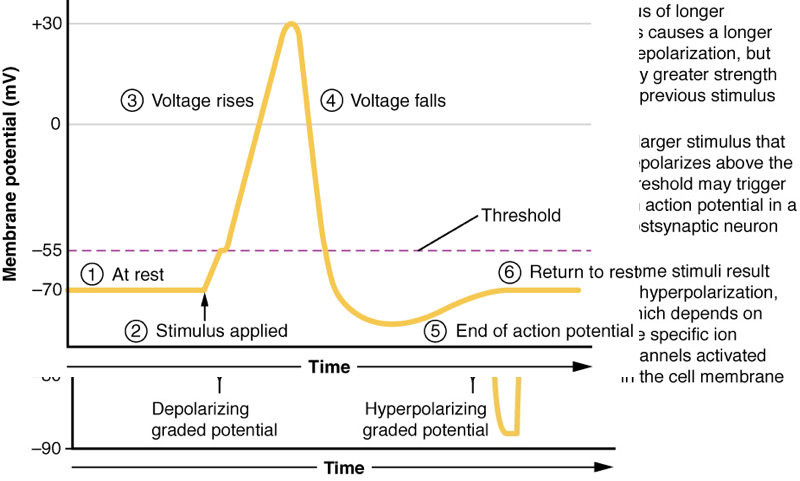

HEK cells were engineered to express either K ir2.1 (an inward-rectifier K + channel) or Na V1.5 (a voltage-gated Na + channel). These results show that a mixture of non-excitable cells can become excitable by sharing currents through gap junctions.Ī, b, A mixture of non-excitable cells can be excitable.

In cultures expressing either Na V1.5 or K ir2.1 alone, optical activation of CheRiff did not lead to APs or wave propagation (Extended Data Fig. These APs were quantified by the fractional change in fluorescence, Δ F/F, of the BeRST1 indicator. Localized optogenetic stimulation evoked APs that propagated radially outwards (Fig. We mixed the cell populations in a 1:1 ratio and mapped the voltage in confluent monolayer cultures using the far-red voltage-sensitive dye BeRST1 ( Methods) 31. We made separate pools of HEK cells that expressed CheRiff and either Na V1.5 alone or K ir2.1 alone (Fig. 30) and either express a far-red voltage-indicator protein 21 or are labelled with a red-shifted voltage-sensitive dye 31, then one can optically induce APs and simultaneously map their propagation through the engineered tissue 22, 28, 32.įirst, we explored whether the sodium and potassium channels needed to be in the same cells. If the cells further express a blue-light-activated cation channel such as CheRiff (ref. When grown in a confluent monolayer, endogenous gap junctions introduce nearest-neighbour electrical coupling, which can then support propagating electrical waves. Human embryonic kidney (HEK293) cells become electrically excitable when genetically engineered to express an inward-rectifier potassium channel (for example K ir2.1 or K ir2.3) and a voltage-gated sodium channel (for example Na V1.3 (ref. A theoretical analysis of interfacial APs revealing how their properties stem from topological features of the underlying non-linear dynamics (beyond topological band theory) will be presented separately (C.S. These findings suggest a mechanism of bioelectrical signalling that may arise in native tissues and that might be used in engineering synthetic bioelectrical circuits with applications in sensing, tissue engineering and unconventional computation. Our simulations predict that topological APs are exceptionally robust to variations in ion channel levels compared to ordinary APs. Detailed numerical simulations and a simple analytical model capture the key features of these excitations. In this Article, we map the excitability at interfaces between non-excitable engineered tissues and observe interface-localized (‘topological’) APs. Engineered and patterned cells have been a powerful tool for dissecting intercellular molecular signalling cascades 23, 24, but despite some theoretical work 25, 26, this approach has not previously been applied experimentally to bioelectrical signalling in heterogeneous tissues. This approach has been used to identify bioelectrical domain walls in engineered tissues 22 and also to map bioelectrical signals throughout embryonic development 1, 20. By combining patterned optogenetic stimulation and high-speed voltage imaging, one can probe the excitability of a complex tissue as a function of space and time. Recent advances in voltage imaging 20, 21 opened the door to studying the spatial structures of bioelectrical excitations. Historically, spatial structures in bioelectrical signalling have been difficult to investigate experimentally because patch-clamp measurements probed the voltage at only a single point in space. While these systems can often be treated within the topological band theory of linear waves, electrophysiological excitability inherently relies on the topological properties of the underlying non-linear dynamical system. For example, interfacial excitations have been studied in the context of topological insulators spanning electronic 11, photonic 12, mechanical 13, 14, 15, hydrodynamic 16 and biochemical reaction–diffusion 17, 18, 19 systems. Robust excitations localized at interfaces are a burgeoning area of basic research and technology 10. This continuity requirement on the membrane voltage opens the possibility of robust interfacial action potentials (APs) that would not be supported by the bulk media on either side of the interface. In particular, can the interface between two non-excitable tissues be excitable? When cells are gap junction-coupled across the interface, the voltage along a line transverse to the interface must interpolate between steady state voltages of the two halves, including possibly going through unstable or metastable regimes. Less is known about the fate of such patterns when tissues with different resting potential are in contact. Patterns of membrane potential are thought to play a critical role in many biological patterning processes 1, 2, 3, 4, 5, 6, 7, 8, 9.


 0 kommentar(er)
0 kommentar(er)
